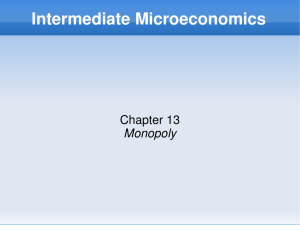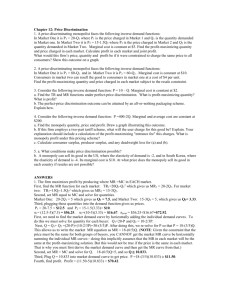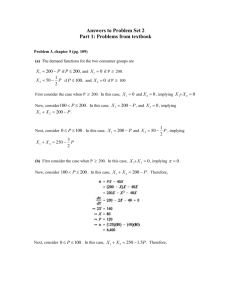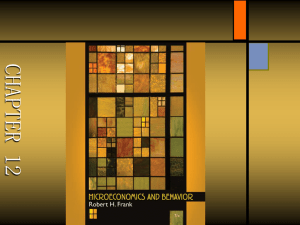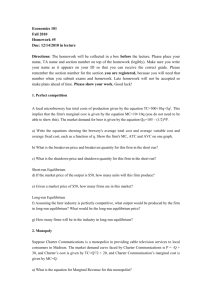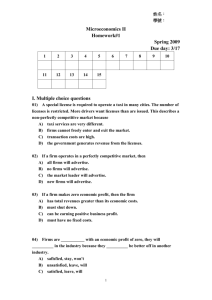Chapter 13 Practice Exam Solutions
advertisement
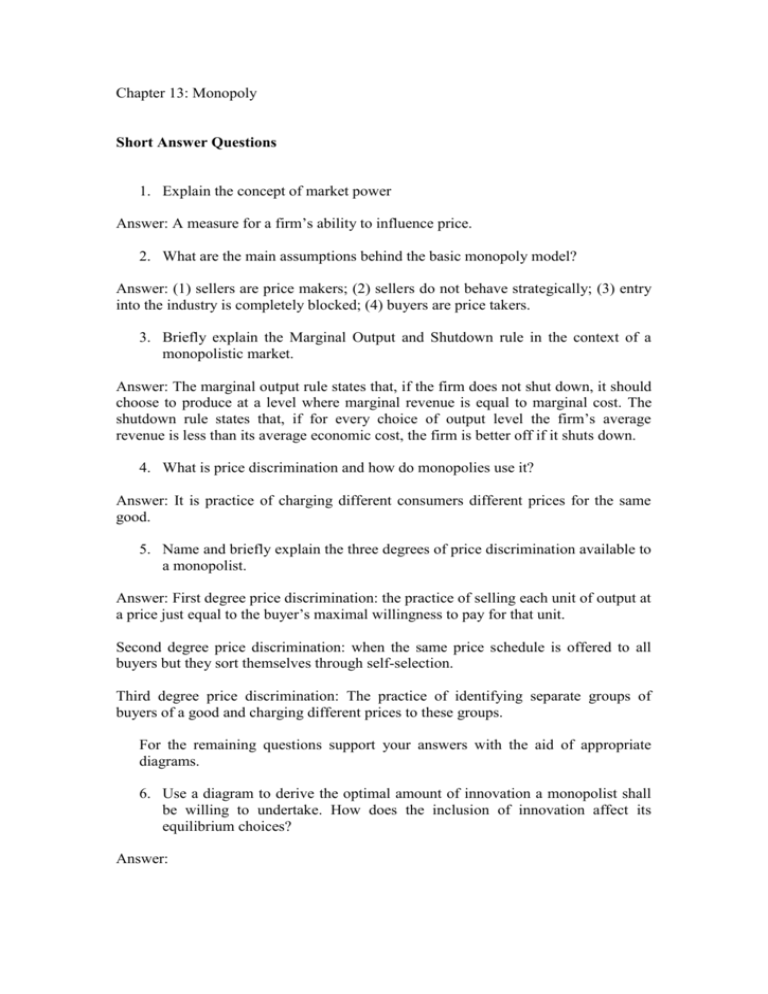
Chapter 13: Monopoly Short Answer Questions 1. Explain the concept of market power Answer: A measure for a firm’s ability to influence price. 2. What are the main assumptions behind the basic monopoly model? Answer: (1) sellers are price makers; (2) sellers do not behave strategically; (3) entry into the industry is completely blocked; (4) buyers are price takers. 3. Briefly explain the Marginal Output and Shutdown rule in the context of a monopolistic market. Answer: The marginal output rule states that, if the firm does not shut down, it should choose to produce at a level where marginal revenue is equal to marginal cost. The shutdown rule states that, if for every choice of output level the firm’s average revenue is less than its average economic cost, the firm is better off if it shuts down. 4. What is price discrimination and how do monopolies use it? Answer: It is practice of charging different consumers different prices for the same good. 5. Name and briefly explain the three degrees of price discrimination available to a monopolist. Answer: First degree price discrimination: the practice of selling each unit of output at a price just equal to the buyer’s maximal willingness to pay for that unit. Second degree price discrimination: when the same price schedule is offered to all buyers but they sort themselves through self-selection. Third degree price discrimination: The practice of identifying separate groups of buyers of a good and charging different prices to these groups. For the remaining questions support your answers with the aid of appropriate diagrams. 6. Use a diagram to derive the optimal amount of innovation a monopolist shall be willing to undertake. How does the inclusion of innovation affect its equilibrium choices? Answer: Without the innovation, the monopolist’s marginal cost curve is MC, the equilibrium point is e1, and profit is shaded area A. With the innovation, the firm’s marginal cost curve falls to MC’′. The equilibrium point becomes e3, and the resulting profit is the sum of shaded areas A and B. Hence, area B is the amount that the monopolist is willing to spend to obtain the innovation. 7. Using an appropriate diagram, show how imposing a unit-tax on a monopolist would affect its equilibrium choice. Answer: D, MR and MC are Cologne Chemical’s before-tax demand, marginal revenue and marginal cost curves, respectively. At the before-tax equilibrium price (p1) and quantity (X1), the monopolist’s profit is the sum of shaded areas A, B and C. The tax shifts the firm’s marginal cost curve upwards by t per litre to MCt. The new equilibrium quantity and price are X2 and p2. After-tax profit falls to shaded area A. 8. Use an appropriate diagram to illustrate the social cost of monopoly. Answer: Total surplus is maximised by producing at the output level where the height of the demand curve is equal to the height of the marginal cost curve, XT. Taking the difference between total surplus at this output level and total surplus under the monopoly outcome, we see that monopoly gives rise to a deadweight loss equal to the sum of areas E and F. 9. Using an appropriate diagram, show how first degree price discrimination can be used by a monopolist to increase its profits. Answer: Because it can price discriminate, the firm works its way down the demand curve by selling each unit of the program at a price just equal to the buyer’s willingness to pay for that unit which is given by the height of the demand curve. 10. Repeat the exercise for second-degree price discrimination. Answer: Assume there are two types of consumers. If the monopolist sets the per unit charge equal to marginal cost, then shaded area G is the highest fixed fee it can charge without driving Consumer 1 from the market. Under this tariff, Consumer 2 enjoys surplus equal to area H. To extract some of this surplus, the firm will set the per-unit charge above marginal cost. Essay questions 1. “Any market structure can support monopoly model”. Discuss. Answer: Wrong. The following market features need to be in place: (a) sellers are price makers (b) sellers do not behave strategically (c) entry into the industry is completely blocked, and (d) buyers are price takers. 2. Discuss the necessary conditions for price discrimination to be profitable. Answer: There are three necessary conditions that must be satisfied: (a) the firm must be a price maker (b) the firm must be able to identify which consumer is which and (c) consumers must not be able to engage in arbitrage. The reader should explain the reason why each condition is necessary. The full discussion can be viewed in chapter 13, p 471-472. 3. “Monopolies are bad for social welfare, compared to perfect competition”. Discuss. Answer: Total surplus is maximised by producing at the output level where the height of the demand curve is equal to the height of the marginal cost curve, XT. Taking the difference between total surplus at this output level and total surplus under the monopoly outcome, we see that monopoly gives rise to a deadweight loss equal to the sum of areas E and F. 4. Discuss what forms of regulation can be used to deter monopolies or limit their ability to exercise their market power. Answer: Conduct remedies, structural remedies, anti-trust laws. See chapter 13.3 for discussion. 5. Discuss how equilibrium is achieved when the monopolist practices third degree price discrimination. Use examples and appropriate diagrams to support your answer. Answer: When marginal costs are constant, a discriminating monopolist simply sets marginal revenue for each market equal to the constant value of marginal cost. The firm charges a price of 40 to mainframe users and 30 to PC users.


